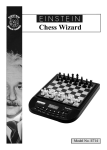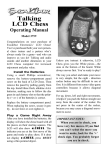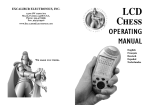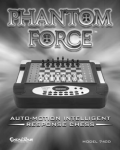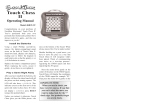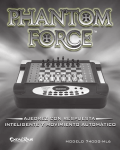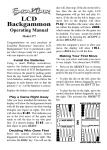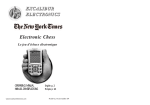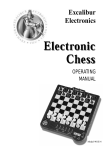Download Excalibur E123 User`s manual
Transcript
LCD Chess Wizard Model No. E123 C ongratulations on your purchase of Einstein LCD Chess Wizard. Now, the challenging game of Chess can travel with you anywhere. Einstein LCD Chess Wizard offers varying levels of challenging computer opponents, has simple, intuitive controls and is an expert chess teacher! Albert Einstein is probably best known for his famous formula, E=mc2, but this German-born theoretical physicist made unparalleled contributions to modern scientific thought. In the field of physics, he introduced his special theory and general theory of relativity and, in 1921, his work on the photoelectric effect won him the Nobel Prize in Physics. Einstein enjoyed playing the violin and for much of his life, greatly enjoyed the game of chess. He routinely asked children he met if they liked music or if they could play chess. He would then teach them the basics of the game, and would play that child every time that they met. ABOUT ALBERT EINSTEIN Born: March 14, 1879 Ulm, Württemberg, Germany Notable Awards: Nobel Prize in Physics (1921) Copley Medal (1925) R.A.S Gold Medal (1925) Max Planck Medal (1929) Benjamin Franklin Medal (1935) Died: April 18, 1955 (aged 76) Princeton, New Jersey, USA Residence: Germany, Italy, Switzerland, USA Citizenship: German (1879-1896, 1914-1933) Swiss (1901-1955) American (1940-1955) Honorary Doctorates: Princeton (1921) Oxford (1931) Harvard (1935) Quotes: “Whoever undertakes to set himself up as a judge of Truth and Knowledge is shipwrecked by the laughter of the gods.” “The secret to creativity is knowing how to hide your sources.” “ALBERT EINSTEIN and related rights TM/© of HUJ, used under license. Represented exclusively by Corbis Corp.” Items Included 1 Einstein LCD Chess Wizard Unit 1 User’s Manual 2 You’ll see the piece flash on its from square and move to its to square. You're already playing a game! Enjoy the contest. Install the Batteries Using a small Phillips screwdriver, remove the screw from the battery-compartment panel on the back of LCD Chess. Install two fresh, alkaline AAA batteries, making sure to follow the diagram in each battery slot so that the polarity (+ or -) of the batteries is correct. Putting a game “on hold” Any time it's your move and you wish to stop playing for a while, just press the ON/OFF key. LCD Chess will switch off and go into a sleep mode. It will remember the last position, including the elapsed time, as long as you do not interrupt the power supply-for example, by removing the batteries. To resume play, just press the ON/OFF key. Replace the battery compartment panel. When replacing the screw, secure it gently, do not force or over-tighten it. Play a Game Right Away After you have installed the batteries, the display will show the chess board with all the pieces on their starting squares. The LCD will also show PLAY. If it does not display PLAY, press RESET using a thin pointed object. NOTE: If it is not "thinking," LCD Chess will automatically turn off after a period of time, saving your game position. Use the ON/OFF key to resume the game. Unless you instruct it otherwise, LCD Chess gives you the White pieces—the ones at the bottom of the board. White always moves first. You’re ready to play! KEY LAYOUT The way you select and make your move is very simple. • Press the NEXT PIECE or PREVIOUS PIECE key to choose the piece you want to move. Key Functions PREVIOUS PIECE KEY Press repeatedly to scan backwards to select a piece to move. • The first move for that piece will flash. If you wish to select a different move for that piece, press the NEXT MOVE or PREVIOUS MOVE key. (If you want to make a capture, it will be quicker to use the PREVIOUS MOVE key instead of the NEXT MOVE key). NEXT PIECE KEY Press repeatedly to scan forewards to select a piece to move. • Press the GO key to enter your selected move into the computer. PREVIOUS MOVE KEY Press repeatedly to scan backwards through all legal moves of the selected piece. NOTE: This key shows all legal After you make your move, LCD Chess will reply with its move automatically. 3 capture moves first. If you want to make a capture, use this key to quickly select your capture move. SETUP KEY To setup or modify a position. (see page 9) NEXT MOVE KEY Press repeatedly to scan forward through all legal moves of the selected piece. NEW KEY Use this key to start a new game whenever it is your turn. ON/OFF KEY Use this key to turn LCD Chess off and on. LCD Chess will remember the board position while it is off. / KEY Press this key to see the contrast setting , Cn 4 for example. Use the + or - keys to change the setting. Press the / again or press CLEAR to resume play. LEVEL KEY Press this key to see the current level. Press the + or - keys to increase or decrease the level. Press the LEVEL key again to change the level type. Press CLEAR to resume play. (see page 7) During SETUP use this key to change color to move or the color of the piece being setup (see page 9). OPTIONS KEY Pressing the OPTIONS key displays a number of options. To view a different option, press the OPTIONS key again, or the / key. Press CLEAR to resume play. TRAIN KEY Press this key to select a training position at the beginning of a game. Use the + or the - key to select one of eight training positions. Positions with the Black king in the middle give you practice in checkmating the Black king. Press CLEAR to start play. (see page 8) Also use this key to flash the piece that is threatened when the threat warning “!” ICON is on. +HINT KEY Press this key if you want to get hints from your LCD Chess partner. It displays HINT and flashes a recommended move on the screen. To make the hint move, just press the GO key. CLEAR KEY Use this key to exit any of the special modes like OPTIONS, SETUP, and LEVEL. Also use this key during move entry to clear your move entry , and start the move entry process over. If the hint is a book move or a replay move, OPEN or RPLY will be shown instead of HINT . IMPORTANT NOTE: When you are in check, you have very few moves. If you find you can’t select the move you want to make, look for the ‘+’ check sign. You probably forgot you are in check. Also use this key during SETUP mode to select the next piece type. -UNDO KEY This key lets you take back a move or moves you’ve decided against. Press this key repeatedly to continue taking back 4 moves. After you take back a move, you can use the GO key to replay the takenback move or moves. scoring totals the following values: Pawns—1, Knights—3, Bishops—3, Rooks—5, and Queen—9. Also use this key during SETUP mode to select the previous piece type. HELP: When turned on, all legal moves for the selected piece will be shown at one time. GO KEY Press this to to register your move, or press this key twice before you register your move to switch sides (colors) with your LCD Chess. (Between presses, the display will show FLIP.) Also use GO to replay moves in the takeback move mode (see "-UNDO,” on left). NOTE: When the HELP option is on, possible capturing moves are shown by flashing the captured pieces central black figure. Do not confuse this with selecting a capture move, which flashes the entire piece that is to be captured. inFO: When turned on, this option will display the score, depth of search (number of moves LCD Chess is "thinking ahead"), best move it is considering playing, and clock times. These will be displayed while the computer is thinking at its higher levels. Use the + or the - keys to change the condition of the following options. Options Menu Press OPTIONS to enter the options menu and repeatedly press to cycle through the menu of options. Press the CLEAR key to resume play. FLiP: Use this option to turn the chess board around. SLEP: Adjust the automatic shut off time with this key. Setting it to ‘0’ will disable auto shut-off altogether. Menu Options Before the Game Starts OPEN: Use the + or the - key to select one of 32 book opening lines of play. (See page 6.) CLbr: Pressing the GO key now, will enter SETUP mode with the chess board with only the White king. You must place a White and Black king on the board to exit SETUP mode. Use this option to clear the chess board for easier problem setup. Options Before and During the Game bEEP: Use this option to turn the sound On or off. Playing the Black Pieces PLYr: Select between: ‘1’—Human vs Computer; ‘2’—Human vs Human; ‘0’—Computer vs Computer. When you want to play the Black pieces (to let LCD Chess move first) press the GO key before you make your first move as White. You’ll see the White and Black pieces switch places immediately! SCOr: Turn this option OFF to display the move counter instead of the score. If you want to see the piece-score of your current position, turn this option on. The 5 auto play at any time by pressing the GO key. Doing so will set the number of players back to one. Draw Messages During the game, your LCD Chess will display the word drAU if a three-time repetition of position occurs, or if there has been no pawn moved and no exchanges for 50 moves. When either of these situation takes place, the rules of chess state that a player can claim a draw. If you wish, you can ignore the message and continue the game. When a stalemate is reached, the display will show StAL. Book Opening Trainer LCD Chess makes it easy for you to learn the same openings that world chess champions play! At the beginning of a game, you may choose to learn one of 32 popular book openings—ways to begin the game—used by chess masters. Press the OPTIONS key to display OPEN, and then press the + or - button to select the number of the opening you want to learn. (See below.) Press the CLEAR key to return to normal play. Game-Ending Messages LCD Chess will announce mate in two (MAtE2) and mate in three (MAtE3). It will also display +MAtE when executing a checkmate or when you checkmate LCD Chess. Now play a move. If your move is not the correct opening move, an error buzz will sound. To learn the correct move press HINT. When the computer comes back with its move, you will briefly see the word OPEN on the screen if you have another opening move to make. If the word OPEN does not appear, you may continue normal play sinceyou have completed the training for that opening line. Screen Symbols When a ‘+’ appears on the screen, it is a reminder that you are in check. When an ‘=’ appears, it indicates you are in two human player mode. And lastly when an ‘!’ appears on the screen, you are being warned that one of your pieces is threatened with capture. (This is similar to the friendly "en garde" warning sometimes used by human players when they are attacking an opponent’s queen.) To see which of your pieces is threatened, press the OPTIONS key. The names of the openings are: 1. Ruy Lopez, Open Defense 2. Ruy Lopez, Zaitsev Defense 3. Ruy Lopez, Exchange 4. Scotch Game 5. Scotch Four Knights 6. Giuoco Piano 7. Two Knights Defense 8. Four Knights 9. Petroff’s Defense 10. Sicilian Alapin Variation 11. Sicilian, Najdorf Variation 12. Sicilian, Dragon Variation 13. Sicilian, Keres Attack 14. Caro-Kann Defense 15. Panov-Botvinnik Attack 16. Caro-Kann Excahnge Variation Auto Play If you would like to watch the computer finish a game for you automatically, press the OPTIONS key repeatedly until the option PLYr is showing. Use the + button to change the number of players to zero. Press CLEAR to exit the OPTIONS mode. Now press the GO key twice and watch the game play itself. You may stop 6 Beginner Level Type 17. Queen’s Gambit Declined 18. Lasker Defense, Queen Gambit Declind 19. Queen Gambit Declined Exchange Var. 20. Slav Defense 21. Queen’s Gambit Accepted 22. Nimzo-Indian Defense, Classical Var. 23. Nimzo-Indian Defense, Rubinstein Var. 24. Semi-Slav Defense 25. Queen’s Indian Defense 26. Queen’s Indian Defense, Petrosian Var. 27. Bogolubow Indian Defense 28. Catalan 29. Gruenfeld Defense 30. King’s Indian Defense 31. Modern Benoni Defense 32. Benko Gambit Press the + or - button to select 1, 2, 3, 4, 5, 7, 10, or 15 seconds per move. B 001 B 002 B 003 B 004 B 005 B 007 B 010 B 015 Fixed Time Level Type Press the + or - button to select 1, 2, 3, 5, 10, 15, 20, 30, 45 seconds, and 1:00, 1:30, 2:00, 2:30, 3:00, 5:00 minutes per move. FIXED Time Level "inf" is infinite time, and will only stop thinking when the GO key is pressed, or a mate is found. F 001 F 002 F 003 F 005 The moves and explanations of these famous openings are given in many books on chess. F 010 F 015 F 020 F 030 F 045 F 100 F 130 F 200 Entering Your Own Opening LCD Chess also allows you to set up any book opening you want—or even an opening you invent—to practice. Press OPTIONS repeatedly until the display shows PLYr. Use + button to set players to 2. Press CLEAR, then make moves for both sides until the opening position you want to practice is reached. Now press OPTIONS repeatedly until the display shows PLYr. Use the + button to set players to 1. Press CLEAR and play against the computer in this position. F 230 F 300 F 500 F inF Sudden Death Level Type Press the + or - button to select the amount of time in minutes for the entire game. If you run out of time you lose or forfeit, FrFt will be shown on the display. After every move, you receive a bonus 10 seconds to make up for the time it takes to enter your move. S 05 S 10 S 15 S 20 S 30 S 45 S 60 S 90 Levels of Play Tournament Level Type Press LEVEL to see the current level. When you are finished reviewing the level or changing the level, press CLEAR to return to normal play. Press the + or - button to select the the amount of time in MINUTES to play the number of moves shown on the left side of the display. If you run out of time before you play the indicated number of moves, you lose or forfeit, FrFt will be shown on the display. After every move, you receive a bonus 10 seconds to make up for the time it takes to enter your At this point you may press LEVEL again to change to a different level type. There are six types of levels. 7 move. these basics, just as a concert pianist continues to practice the scales so that they remain second nature. Like any great trainer, LCD Chess will play you these special practice games. 40T 030 45T 045 40T 060 40T 090 35T 090 45T 115 40T 120 45T 145 PLy Level Type MAtE Solver Level Type First make sure you are at the start of a game. Now press TRAIN button, then repeatedly press the + key. The minigames always include the king and pawns for both sides. In fact, one mini-game contains just this material (see figure on left). Press the + or - button to select the number of moves to mate the program will search. nOnE will appear if no mate is found. The other four mini-games use kings and pawns, but add a different single piece to the exercise-knight, bishop, rook, and then queen. MAt 1 MAt 5 Start with the basic king and pawns minigame. Press the + or - button to select the depth of search from 1 to 8 ply. A ply is one half move. PLY 1 PLY 5 PLY 2 PLY 6 MAt 2 MAt 6 PLY 3 PLY 7 MAt 3 MAt 7 PLY 4 PLY 8 MAt 4 MAt 8 Make your first move. Your object, as in regular chess, is to checkmate the king. Normally, this means both sides will try to force a pawn through to the other side of the board safely to promote it to a queen. You'll learn lots of principles, tricks, and traps in this training mode that will win you many full-fledged chess games! Note: You can only change the level while it is your turn to play. Checkmate Training The main objective in the game of Chess is to checkmate your opponents king. LCD Chess, has three special positions that are shown after the five piece training mini games. The Black king will be in the center of the board in those positions. Select one of those positions to practice and improve your technique to checkmate your opponent’s king. Kings & Pawns Training Piece Training There are five special mini-games and three mate training positions. The most famous and successful chess teachers in the world take their beginning students from the simple to the complex by having them play "mini-games" of chess that concentrate on just one or more types of pieces. Even advanced players practice 8 / button. The color icons and below PrOb will show the side to move. Using Setup Mode At any time during a game when it is your move, you may change the position on the board by adding a piece, removing a piece, or changing any of the pieces—for example, from a queen to a knight. Use the PREVIOUS PIECE, NEXT PIECE, PREVIOUS MOVE, NEXT MOVE buttons to move the king to the square the White king is on. Press GO to place that the piece on the board. Removing A Piece Press SETUP then use the PREVIOUS PIECE, NEXT PIECE, PREVIOUS MOVE, NEXT MOVE buttons to move the king cross over a piece. Press GO to remove the piece. Press CLEAR to continue the game. Use the PREVIOUS PIECE, NEXT PIECE, PREVIOUS MOVE, NEXT MOVE buttons to move the king to the square the Black king is on., and then press the / button to change the White king to a Black king. Press GO to place that the piece on the board. Adding or Changing a Piece Press SETUP then use the PREVIOUS PIECE, NEXT PIECE, PREVIOUS MOVE, NEXT MOVE buttons to move the king cross to the desired square. Now press the + or - buttons for the desired piece. Press GO to place that the piece on the board. Press CLEAR to continue the game. Next, pick out another piece in the problem or position you want to set up. Now press +HINT button repeatedly to select the correct piece. Use the PREVIOUS PIECE, NEXT PIECE, PREVIOUS MOVE, NEXT MOVE buttons to move to the desired square. Press GO to place that the piece on the board. Setting Up Special Positions This is another terrific feature that allows you to solve problems that you see in magazines or newspapers, or that you make up yourself. It also allows you to enter game positions you want to play, or that you want LCD Chess to look at, perhaps using the Infinite Search level. Follow this procedure until all the pieces in the problem or position are completely set up. Finally, press CLEAR to play or to have LCD Chess analyze the position. NOTE: You must place a White and Black king on the board to exit SETUP mode with the CLEAR key. Normally, it is easier to start from an empty board to set up such problems. So first, press OPTIONS repeatedly until CLbr (clear board) is displayed. Then press the GO key. You’ll see that the display chessboard will have only the white king, and PrOb is displayed. General Rules of Chess 1. The two players must alternate in making one move at a time. The player with the white pieces moves first to start the game. 2. With the exception of castling (see below), a move is the transfer of a piece from one square to another square which is vacant or occupied by an enemy piece. Make sure that LCD Chess knows which color is to move. You may change the color of the side to move by pressing the 9 3. No piece, except the Knight may cross a square occupied by another piece. 4. A piece moved to a square occupied by an enemy piece captures it as part of the same move. The captured piece must be immediately removed from the chessboard by the player making the capture. 5. When one player moves into a position whereby he can attack the King, the King is in “Check”. His opponent must either a) move the King b) block the path of the attacking piece with another piece, or c) capture the attacking piece. 6. The game is over when there is no escape for the King from an attacking piece. This is known as “Checkmate”. 7. The game is over when the king of the player whose turn it is to move is not in check and the player cannot make any legal moves. This is known as “Stalemate” and is considered a drawn game. piece. See also Castling (below.) 3. The Bishop can move to any square along the diaganols on which it stands, but cannot pass over an enemy piece. 4. The Knight move is in the shape of an “L”, moving two squares up or down, and then one square over. Or it can be one square up or down, and then two over. 5. The Pawn can move one square forward. On it’s first move it may move two squares forward. When capturing, it moves diaganolly (forward) one square. See also en passent (below.) 6. The King can move one square in any direction, as long as it is not attacked by an enemy piece. See also Castling(below) Special Moves 1. Castling is a move of both the King and either Rook which counts as a single move (of the King) and is executed as diagrammed below: Castling cannot occur if: a) the King has already been moved. b) the Rook has already been moved. c) there is any piece between the King and the Rook. d) the King’s original square, or the square which the King must cross, or the one which it is to occupy is attacked by an enemy piece. 2. A Pawn may make an en passent capture if it is a reply move to a double pawn move, and it is a Pawn which is side-byside with the Pawn which made the double pawn move. The capture of a white Pawn is diagrammed on right: Individual Moves Turn on the HELP feature (see page 5.) All legal moves for each selected piece will be shown at one time. You will quickly “learn by doing” the movements of all pieces. 1. The Queen can move to any square along the same row, column, or diaganols on which it stands, but cannot pass over an enemy piece. 2. The Rook can move to any square along the same row or column on which it stands, but cannot pass over an enemy 10 Battery Information • Your LCD Chess uses 2 “AAA” batteries. • Do not mix old and new batteries. • Do not mix alkaline & standard or rechargeable batteries. • Install batteries so that the polarity (+ and -) matches the diagrams in the battery compartment. • Use only batteries of the same type and equivalency. • Remove exhausted batteries from the unit. • Do not short circuit battery terminals. 3. A Pawn can be promoted if it advances all the way to the far side of the board. It is immediately promoted, as part of the same move, into a Queen, Rook, Bishop, or Knight, whichever its owner chooses. Since a Queen is the most powerful piece, it is nearly always chosen as the promotion piece. Through the promotion process, there may be more than one Queen on the board at the same time. Some Tips on Chess 1. Castle your King into safety as soon as possible. 2. If you control the center squares you will achieve an advantage. To do this move your center Pawns and develop your Bishops and Knights early in the game. 3. Take advantage of capture situations, particulary if you will gain material. Special Care • Avoid rough handling such as bumping or dropping. • Avoid moisture and extreme temperatures. For best results, use between the temperatures of 39ºF and 100ºF (4ºC and 38ºC). • Clean using only a slightly damp cloth. Do not use cleaners with chemical agents. Computers can sometimes "lock up" due to static discharge or other electrical disturbances. If this should happen, use a slim, pointed object to press the button marked “RESET.” Excalibur Electronics reserves the right to make technical changes without notice in the interest of progress. 11 FCC Notice This device complies with Part 15 of the FCC Rules. Operation is subject to the following two conditions: (1) this device may not cause harmful interference, and (2) this device must accept any interference received, including interference that may cause undesired operation. NOTE: This equipment has been tested and found to comply with the limits for a Class B digital device, pursuant to Part 15 of the FCC Rules. These limits are designed to provide reasonable protection against harmful interference in a residential installation. This equipment generates, uses and can radiate radio frequency energy and, if not installed and used in accordance with the instructions, may cause harmful interference to radio communications. However, there is no guarantee that interference will not occur in a particular installation. If this equipment does cause harmful interference to radio or television reception, which can be determined by turning the equipment off and on, the user is encouraged to try to correct the interference by one or more of the following measures: -- Reorient or relocate the receiving antenna. -- Increase the separation between the equipment and receiver. -- Connect the equipment into an outlet on a circuit different from that to which the receiver is connected. -- Consult the dealer or an experienced radio/TV technician for help. Limited 90 Day Warranty EXCALIBUR ELECTRONICS, INC., warrants to the original consumer that its products are free from any electrical or mechanical defects for a period of 90 Days from the date of purchase. If any such defect is discovered within the warranty period, EXCALIBUR ELECTRONICS, INC., will repair or replace the unit free of charge upon receipt of the unit, shipped postage prepaid and insured to the factory address shown at right. The only authorized service center in the United States is: Excalibur Electronics, Inc. 13755 SW 119th Ave Miami, Florida 33186 U.S.A. Phone: 305.477.8080 Fax: 305.477.9516 www.ExcaliburElectronics.com Ship the unit carefully packed, preferably in the original carton, and send it prepaid, and adequately insured. Include a letter, detailing the complaint and including your daytime telephone number, inside the shipping carton. If your warranty has expired and you want an estimated fee for service, write to the above address, specifying the model and the problem. DO NOT SEND YOUR UNIT WITHOUT RECEIVING AN ESTIMATE FOR SERVICING. WE CANNOT STORE YOUR UNIT! The warranty covers normal consumer use and does not cover damage that occurs in shipment or failure that results from alterations, accident, misuse, abuse, neglect, wear and tear, inadequate maintenance, commercial use, or unreasonable use of the unit. Removal of the top panel voids all warranties. This warranty does not cover cost of repairs made or attempted outside of the factory. Any applicable implied warranties, including warranties of merchantability and fitness, are hereby limited to 90 Days from the date of purchase. Consequential or incidental damages resulting from a breach of any applicable express or implied warranties are hereby excluded. Some states do not allow limitations on the duration of implied warranties and do not allow exclusion of incidental or consequential damages, so the above limitations and exclusions in these instances may not apply. E123-072808-00 12













